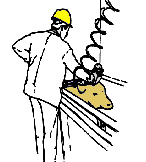



When slaughtering is done carefully cortisol levels in cattle can be substantially lower than farm handling conditions. Tume and Shaw (1992) reported that steers and heifers slaughtered in a small research abattoir had and average cortisol levels of only 15 (ng ml)-1, and cattle slaughtered in a commercial slaughter plant had levels similar to farm handling.Beta-endorphin levels, which is another indicator of stress, were not significantly different between the two groups.
For commercial cattle slaughter with a captive bolt stunning the following average values have been recorded:
- (45 ng ml)-1 (Dunn,1990)
- (25-42 ng ml)-1 (Mitchell et al.,1988)
- (44.28 ng ml)-1 (Tume and Shaw,1992)
- (24 ng ml)-1 (Ewbank et al.,1992)
 When things go wrong the stress levels
increase greatly. Cockram and Corley (1991) reported a median value of
63(ng ml)-1. One animal had a high of 162(ng ml)-1. The slaughter plant
observed by Cockram and Corley (1991) had a poorly designed forcing pen
and slick floors. About 38% of the cattle slipped after exiting the
holding pens and 28% slipped just before entering the race. Cortisol
levels also increased when delays increased waiting time in the single
file race. This was the only study where vocalizations shortly before
stunning were not correlated with cortisol levels. This can probably be
partly explained by earlier stress caused by the slick floors. Ewbank et
al.,(1992) reported the lowest average value. This may be explained by
excellent handling before the stunning box.
When things go wrong the stress levels
increase greatly. Cockram and Corley (1991) reported a median value of
63(ng ml)-1. One animal had a high of 162(ng ml)-1. The slaughter plant
observed by Cockram and Corley (1991) had a poorly designed forcing pen
and slick floors. About 38% of the cattle slipped after exiting the
holding pens and 28% slipped just before entering the race. Cortisol
levels also increased when delays increased waiting time in the single
file race. This was the only study where vocalizations shortly before
stunning were not correlated with cortisol levels. This can probably be
partly explained by earlier stress caused by the slick floors. Ewbank et
al.,(1992) reported the lowest average value. This may be explained by
excellent handling before the stunning box.